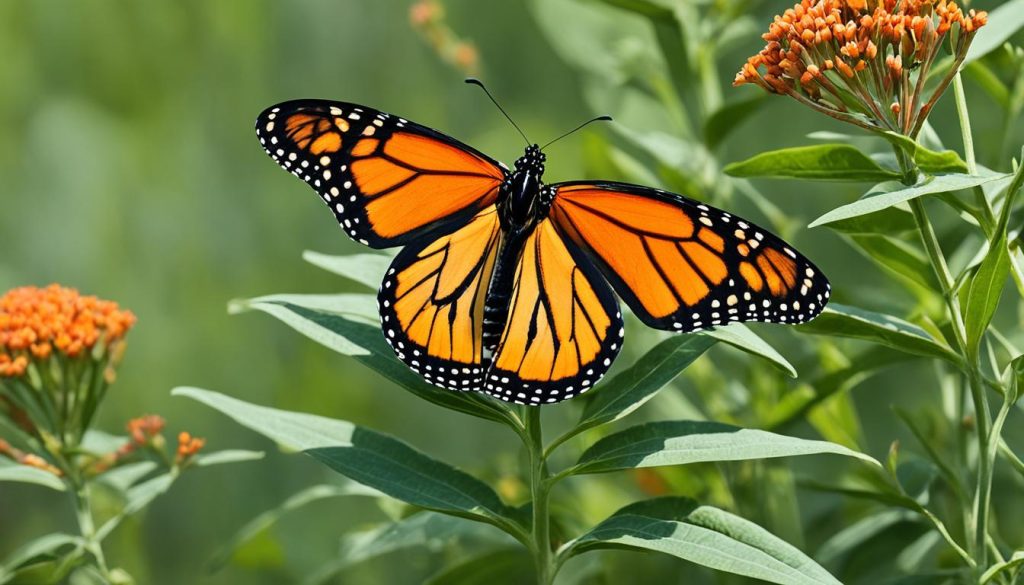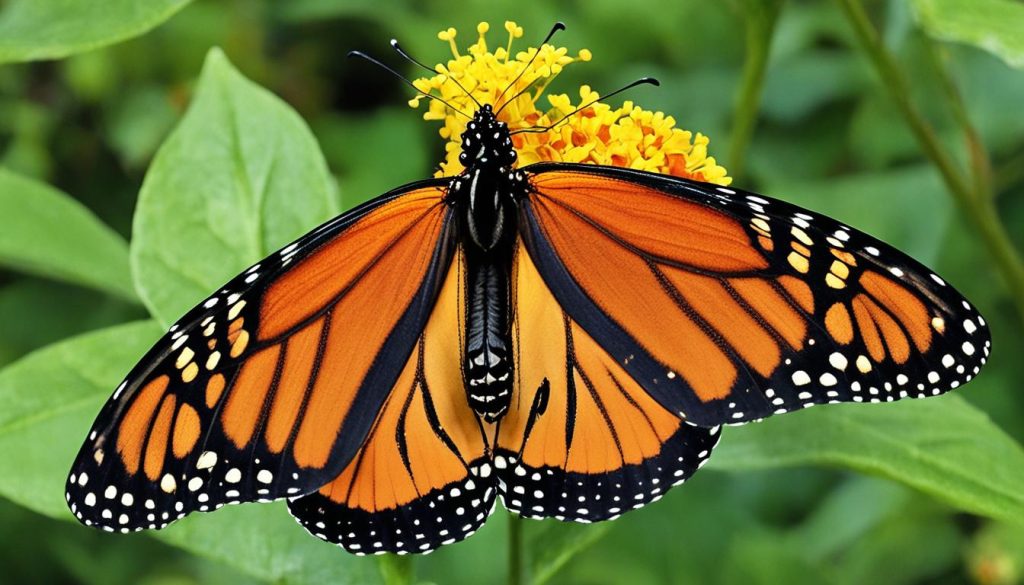Monarch butterflies are fascinating creatures with incredible adaptations that allow them to thrive in their environments. These adaptations, both physical and behavioral, have evolved over time to ensure their survival in the face of various challenges.
One of the most remarkable adaptations of the monarch butterfly is its ability to rely on milkweed plants during the breeding season. While monarchs lay their eggs on milkweed leaves, these plants have their own adaptations to survive freezing temperatures. Monarchs, on the other hand, have developed a built-in strategy: migration. This allows them to take advantage of the abundant milkweed in North America during the summer and avoid freezing to death in the winter.
Monarch butterflies also exhibit a range of physical adaptations. Their large wingspan and vibrant colors serve as warning signals to predators, indicating their toxic nature. This defense mechanism helps deter potential threats and ensures their survival. Additionally, their long proboscis enables them to feed on nectar from flowers, providing them with the energy they need for their migratory journeys.
Behaviorally, monarch butterflies have adapted their mating and breeding patterns to maximize their chances of survival. Their unique courtship rituals and the use of scent glands during mating help ensure successful reproduction. They also exhibit a remarkable sense of direction during migration, allowing them to navigate long distances and find suitable habitats.
Overall, the adaptations of monarch butterflies are a testament to their resilience and ability to overcome challenges. By understanding these adaptations, we can appreciate the marvel of their survival and take steps to protect their habitat and ensure their continued existence.
Key Takeaways:
- Monarch butterflies have evolved various physical and behavioral adaptations for survival.
- Their ability to migrate allows them to navigate long distances and find suitable habitats.
- Milkweed plants play a crucial role in the survival and breeding of monarch butterflies.
- The vibrant colors of monarch butterflies serve as warning signals to predators.
- Understanding and protecting monarch butterfly habitats is essential for their long-term survival.
Monarch Butterfly Migration: A Marvelous Journey

Monarch butterflies embark on an extraordinary annual migration, covering thousands of miles in their awe-inspiring journey. This remarkable migration is a testament to the evolutionary traits and environmental adaptations of these majestic creatures.
Monarchs have developed a built-in survival strategy of migration, allowing them to seek out suitable habitats and resources necessary for their breeding season, such as milkweed plants. By harnessing their evolutionary traits, monarch butterflies can navigate vast distances and endure challenging conditions.
Their migration patterns are a sight to behold, as millions of monarchs gather in clusters and embark on their journey, often traveling from North America to their wintering sites in central Mexico. This migration not only ensures their survival but also provides them with a stable and favorable environment away from freezing temperatures.
During their migration, monarch butterflies exhibit incredible environmental adaptations that aid in their successful journey. These adaptations enable them to navigate through diverse terrains and climates, ensuring their survival throughout the migration process.
The journey of the monarch butterflies highlights the intricate relationship between their evolutionary traits, environmental adaptations, and the need to find suitable habitats for breeding purposes. By understanding and appreciating the marvel of monarch butterfly migration, we gain a deeper appreciation for the wonders of nature.
Join us as we explore the fascinating world of monarch butterflies and uncover their secrets of survival and adaptation in the remaining sections of this article.
Monarch Butterfly Wing Adaptations: The Role of White Spots
Recent research suggests that the white spots on monarch butterfly wings play a crucial role in their long-distance migration. Monarchs with more white spots appear to be more proficient at completing their migration journey. It is believed that these white spots may alter the airflow around the wings, enhancing their flight efficiency.
Additionally, the study found that migrating monarchs have less black and more white on their wings compared to non-migratory counterparts, indicating that the white spots are a significant factor in their successful migration.
| White Spots | Migratory Monarchs | Non-migratory Monarchs |
|---|---|---|
| More white spots | Increased flight proficiency | Lower flight proficiency |
| Less black | Successful migration | Less successful migration |
The presence of these white spots on monarch butterfly wings demonstrates the fascinating physical adaptations that enable them to navigate long distances during their migration. By optimizing flight efficiency, the white spots contribute to the monarchs’ ability to undertake their remarkable journey.
Enhanced Flight Efficiency
Researchers theorize that the white spots on monarch butterfly wings impact airflow, allowing for enhanced flight efficiency. While further studies are needed to fully understand the precise mechanisms behind this adaptation, it is clear that these white spots play a vital role in the monarchs’ successful migration.
“The white spots on the wings of monarch butterflies are a remarkable example of adaptation in action. By manipulating airflow during flight, these butterflies have evolved an efficient mechanism for long-distance migration.”
The white spots’ importance extends beyond their visual appeal; they are instrumental in shaping the monarch butterfly’s ability to navigate vast distances and endure the challenges encountered during their migration.
Threats to Monarch Butterflies and Their Adaptations
Monarch butterflies, like many other species, face numerous threats that impact their population and long-term survival. These threats range from habitat loss to the effects of pesticides and climate change, all of which disrupt their natural adaptations and put their reproductive success at risk.
Habitat loss, particularly the decline of milkweed plants, is a significant threat to monarch butterflies. Milkweed is not only a crucial source of food for monarch caterpillars but also serves as their primary breeding ground. When milkweed plants are lost due to agriculture, urbanization, or other factors, monarchs struggle to find suitable habitats for laying eggs and raising their offspring.
The use of pesticides in agriculture and urban areas also poses a significant challenge to the survival of monarch butterflies. These chemicals not only kill the pests they are targeting but can also harm non-target organisms, including butterflies. Monarchs, in particular, are highly sensitive to pesticides, which can disrupt their reproductive cycles, impair their immune systems, and lead to population declines.
Climate change is another pressing threat that affects monarch butterflies. Rising temperatures, changing precipitation patterns, and extreme weather events can disrupt the availability of milkweed and nectar sources, alter the timing of migration, and impact the overall health and survival of monarch populations.
To mitigate these threats, monarch butterflies have developed various defensive strategies and adaptations. Firstly, they employ their toxic nature as caterpillars to deter predators. Monarch caterpillars feed on milkweed plants, which contain toxic compounds called cardenolides. By sequestering these cardenolides in their bodies, monarch caterpillars become unpalatable to many predators, effectively protecting themselves from being eaten.
Additionally, monarch butterflies use scent glands during mating to ward off potential predators and competitors. These glands emit pheromones that help establish territory and attract mates while also signaling to other organisms that monarchs are toxic and should be avoided.
Adapting to these threats is crucial for the long-term survival of monarch butterflies. Conservation efforts focused on habitat restoration, reducing pesticide use, and addressing climate change are essential to protecting their reproductive adaptations and ensuring the continuation of their incredible life cycle.
| Threats | Impact |
|---|---|
| Habitat Loss | Disruption of reproductive adaptations and breeding patterns |
| Pesticides | Disruption of reproductive cycles, impaired immune systems, population declines |
| Climate Change | Altered migration timing, disruption of food sources, overall decline in health and survival |
Conservation Efforts for Monarch Butterflies

Ecosystems must be protected to ensure the survival of monarch butterflies. Efforts to conserve these magnificent creatures primarily focus on preserving their habitat, with particular emphasis on promoting the planting of milkweed plants. The monarch butterfly habitat adaptations are closely tied to the availability of milkweed, as it is the primary host plant for their larvae. By preserving suitable habitats and reducing pesticide use, we can create a conducive environment for monarch butterflies to thrive.
Understanding the monarch butterfly environmental adaptations is crucial for effective conservation. Monarchs have specific requirements for plant species and climate conditions, which must be taken into account when designing conservation initiatives. By collaborating with experts and conducting research, we can gain valuable insights into the unique adaptations of monarch butterflies and tailor conservation efforts accordingly.
Conclusion
Monarch butterflies are truly resilient creatures, with a wide range of adaptations that allow them to navigate the challenges of their environment. These delicate insects have evolved physical features and behavioral characteristics that help ensure their survival, migration, and success in diverse habitats.
From their stunning wing patterns to their innate navigation abilities, monarch butterflies possess a remarkable range of adaptations. Their physical features, such as the white spots on their wings, play a crucial role in their long-distance migration, enhancing their flight efficiency. Additionally, their behavioral adaptations, including their toxic nature as caterpillars and the use of scent glands during mating, provide them with effective defense and reproductive strategies.
However, monarch populations face serious threats that imperil their survival. The loss of habitat, particularly the decline of milkweed plants, disrupts their breeding patterns and reproductive adaptations. Pesticides and climate change also pose significant challenges, disrupting their migration and survival mechanisms. Efforts to conserve monarch butterflies must focus on protecting their habitats, promoting the planting of milkweed plants, and reducing pesticide use.
By understanding and appreciating the incredible adaptations of monarch butterflies, we can work towards ensuring their continued existence and support their astonishing life cycle and migration. Through dedicated conservation efforts, we can safeguard these remarkable creatures for future generations to admire and appreciate.
FAQ
What are some physical adaptations of monarch butterflies?
Monarch butterflies have developed physical features such as long wings, a lightweight body, and a strong proboscis for feeding.
How do monarch butterflies use behavioral adaptations for survival?
Monarchs use behavioral characteristics like migration, mating behaviors, and the ability to detect suitable habitat to enhance their chances of survival.
What is the purpose of monarch butterfly migration?
Monarch butterflies undertake long-distance migrations to find suitable breeding grounds and escape freezing temperatures in the winter.
How do white spots on monarch butterfly wings help with migration?
Recent research suggests that white spots on monarch wings may enhance flight efficiency and contribute to successful long-distance migration.
What are some threats to monarch butterflies?
Monarchs face threats like habitat loss, pesticide use, and climate change, which can disrupt their reproductive adaptations and migration patterns.
What defensive strategies do monarch butterflies have?
Monarchs have evolved toxic chemicals as caterpillars and use scent glands during mating as defensive mechanisms against predators.
What are the conservation efforts for monarch butterflies?
Conservation efforts focus on preserving habitat by promoting the planting of milkweed, reducing pesticide use, and understanding their environmental needs.






